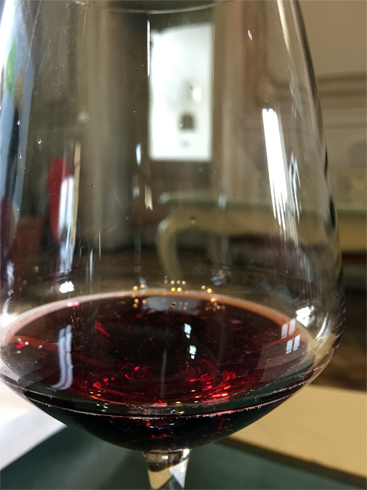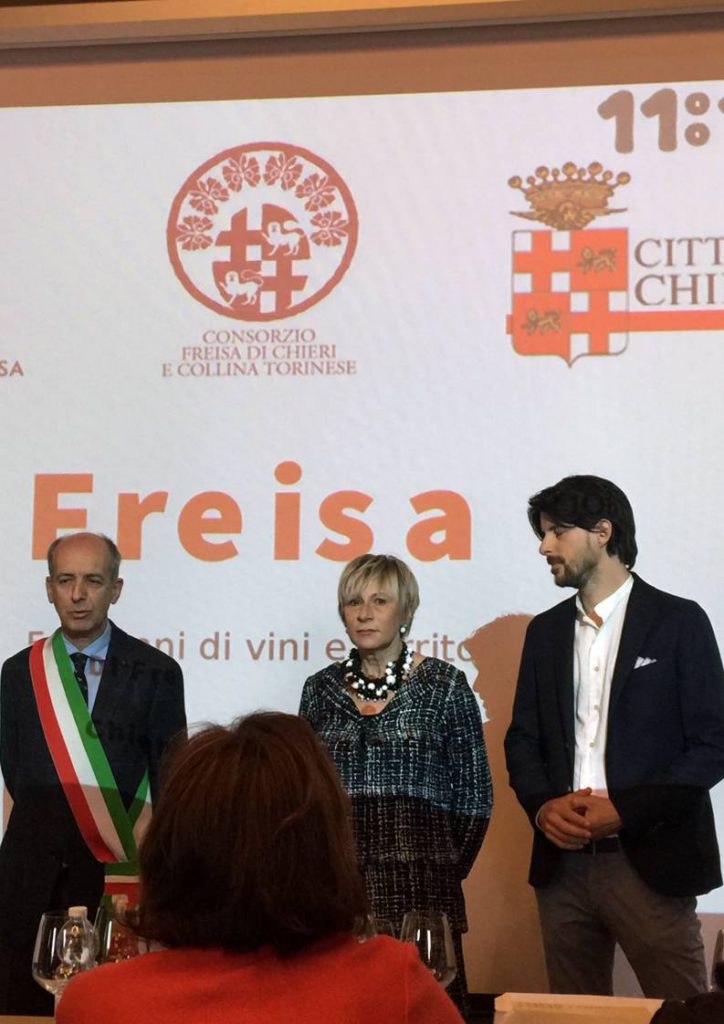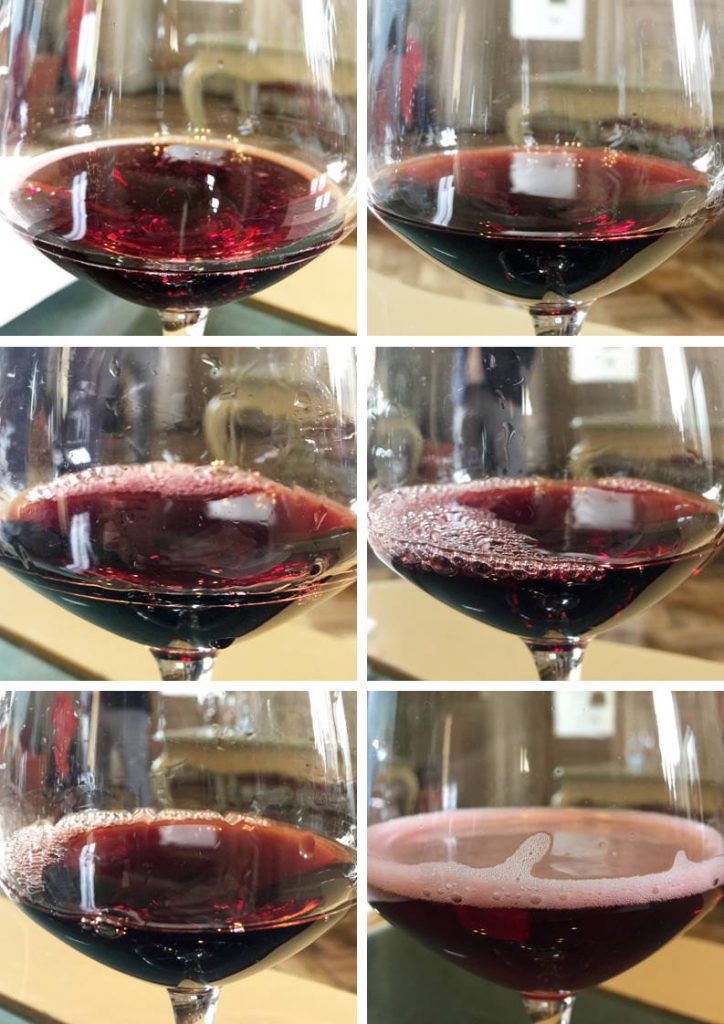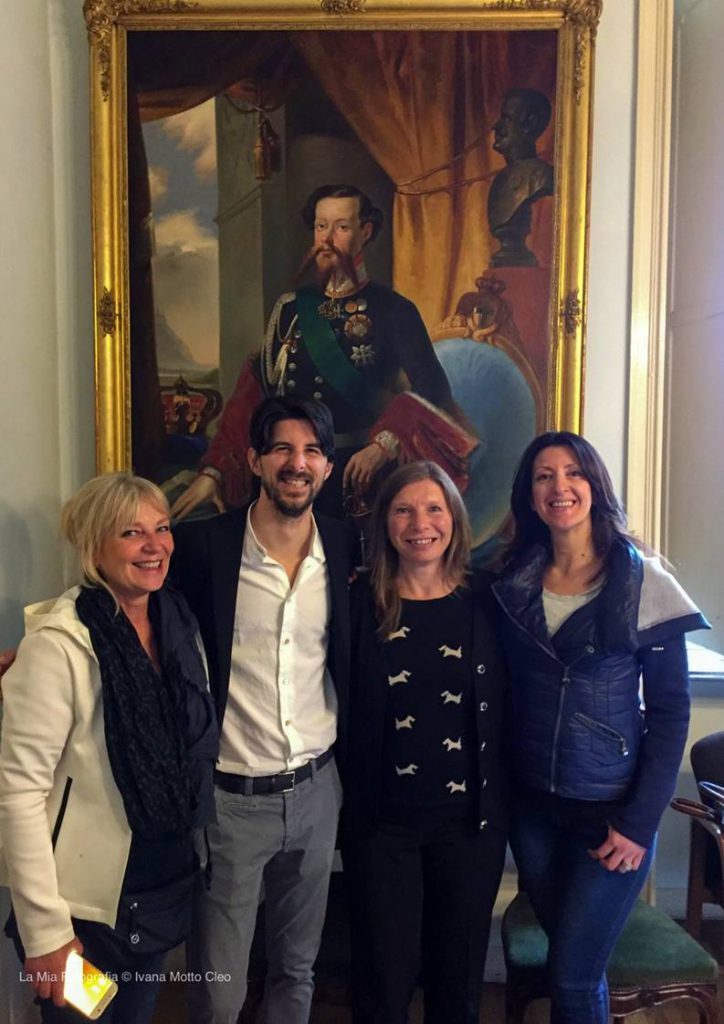La “class” non è acqua, è Freisa | You can’t buy “class”, but you can drink it: Freisa wine

Resoconto della master class dedicata a un vino da ri-conoscere
The diary of a master class dedicated to a wine to re-evaluate

(See the english version below)
Di Paola Uberti
Può essere giovane e può essere matura. Può essere raffinatamente vivace o ferma. Può esprimersi attraverso il colore di un rubino o virare su calde note arancio. Può rallegrare con i gioiosi profumi della frutta rossa o sedurre citando le spezie. Può nascere a Torino, Chieri, Asti, in altre zone del Monferrato, nelle Langhe, sui colli Tortonesi, a Pinerolo. Perché la Freisa è questo: un vino che lascia entrare profondamente in sé il carattere della terra che gli dà vita e i doni che essa può fargli, senza mai perdere in coerenza, identità e capacità di suscitare emozioni.
Un vitigno che ha cinquecento anni di storia, forte, robusto, resistente, che cresce e lussureggia sulle colline, le stesse sulla cui dolce austerità di madri generose, in quelle ore che sono limpido tramonto, si distinguono le sagome della Basilica di Superga, della Villa della Regina, della Basilica di San Giovanni Bosco, per citare alcune tra le anime silenziose di un Piemonte che ha tanto da raccontare.
Trascurata, a volte snobbata, altre ombreggiata dai giganti, la Freisa merita di essere ri-conosciuta, sentita, vissuta.
La Freisa è un vino che, con le sue tante sfumature, può essere un amico con il quale trascorrere ore lievi, un confessore cui affidare una gioia segreta troppo grande per essere trattenuta nel petto, un saggio interlocutore che si dispone al meditare e al filosofeggiare e può rivelarsi spumeggiante complice di quei momenti di festa che parlano di amore, amicizia, famiglia.
Qualcuno che si è fatto carico di rivalutare la Freisa, c’è. Si tratta del Consorzio di Tutela e Valorizzazione delle DOC Freisa di Chieri e Collina Torinese che con l’impegno di, tra gli altri, Luca Balbiano -il presidente- e Giampiero Gerbi, sta portando avanti un programma di iniziative culturali tra le quali la master class del 18 maggio alla quale ho partecipato e l’evento annuale di valorizzazione Di Freisa in Freisa, previsto per i giorni 31 maggio e 1 e 2 giugno 2019.
Il valore dell’attività del Consorzio è grande e trasmette concetti applicabili anche ad ambiti che non hanno a che fare con il vino: conoscere è fondamentale e per farlo è necessario incontrare, ascoltare, fare esperienza diretta, aprendo la mente e mettendo in gioco i cinque sensi.
Una questione di genere e di cavalli imbizzarriti.
Finalmente. A proposito di conoscere e ascoltare per imparare, ma anche per togliersi quei fastidiosi sassolini dalla scarpa che si chiamano dubbi, ho risolto un dilemma (o meglio, me lo hanno risolto). Ora, seguendo Giampiero Gerbi, anche per me LA Freisa indica il vino, mentre IL Freisa designa il vitigno.
Citando ancora Gerbi, una sua frase mi ha colpito particolarmente: ha definito la Freisa un vino austero, elegante, strutturato con «un patrimonio di polifenoli ricchissimo, da domare come un cavallo imbizzarrito che deve essere gestito in vigna e in cantina. » Un cavallo imbizzarrito: quanta potenza poetica…

Potenza poetica che si manifesta anche nelle origini, non prive di un po’ di mistero, di questa eccellenza in forma liquida che condivide il 90% del proprio DNA con il vitigno Nebbiolo. C’è da chiedersi se il Freisa, del Nebbiolo, sia figlio o fratello. Potrebbe esserne figlio, ma l’altro genitore è sconosciuto: forse si tratta di un vitigno scomparso. Ciò che è certo è che il Piemonte è la casa natale del Freisa, identificato come vitigno autoctono, come ha rivelato la mappatura genetica della vite, e che sono le colline con le loro caratteristiche in fatto di terreno, temperature e durata dell’irraggiamento solare, a conferire all’uva e al vino peculiarità univoche, distintive e identificanti della terra stessa e del lavoro di chi a essa si dedica.
Provate a gustare Freisa della medesima annata prodotte in territori differenti: scoprirete vini dal portamento simile, ma dal carattere differente, come sono differenti le sensazioni che essi suscitano e trasmettono.
C’è un tempo per le fragole e un tempo per le spezie.
Se la Freisa raccontasse la sua storia, vi direbbe che da giovane era una ragazza a volte ferma, altre in movimento, che amava le fragole e la frutta rossa e che crescendo e affinandosi ha imparato ad apprezzare le spezie e il sonno in un letto di legno.
La Freisa giovane è un vino rosso rubino, molto brillante (caratteristica che non perde mai), di pronta beva, accarezzato da freschi profumi fruttati che fanno pensare alle fragole e ai lamponi. Quando è matura, invece, il suo colore inizia a virare verso calde sfumature d’arancio e il suo profumo si avvicina a quello ammaliante delle spezie dolci che ne fanno un vino, come specificano coloro che lo tutelano, in grado di essere affiancato a più noti giganti, piemontesi e non.
Uno, sei, dieci.
Una degustazione guidata, sei vini, decine di sensazioni: durante la master class, la Freisa si è svelata e mi ha appassionato, anche grazie alle informazioni che mi sono state date e che trovate di seguito, condite con le mie impressioni personali di non esperta di vini, ma di amante del bere bene e responsabile.
Il primo vino assaggiato è stato una Freisa di Chieri secca del 2018, vivace. Una Freisa rosso rubino, il cui movimento si è tradotto in bollicine sottilissime che ben si adattano ai piatti più succulenti e ricchi della cucina tradizionale piemontese, in grado come è di bilanciarli e “pulirli”. Un vino con un fresco profumo di fragola, semplice ma con un tocco particolare, privo di asperità, che non disturba la bocca, perfetto anche per onorare quei momenti in cui due amici s’incontrano e si invitano reciprocamente a bere un bicchiere di buon vino, con storie da raccontare e anime da alleggerire.
Il Langhe DOC Freisa del 2017 che è seguito, prodotto durante un’annata caldissima, con il suo colore più concentrato ma ancora estremamente luminoso, si è fatto conoscere attraverso un profumo che dalla fragola fresca ha virato verso quello della mora matura. Più tattile, spesso, tannico del primo, questo vino chiede di essere abbinato a un cibo grasso cui fare da contrasto.
La variabilità olfattiva e di sapore del Freisa, legati al territorio di produzione, si sono espressi ai massimi livelli quando una Freisa d’Asti del 2016 è stata messa a confronto -esattamente nell’ordine di citazione- con una Freisa di Chieri della stessa annata. Venti chilometri di distanza tra le due aree bastano a caratterizzare in modi differenti il vino nato dal medesimo vitigno.
Nella Freisa d’Asti, il colore si è fatto intenso e virante al violaceo, il profumo più incisivo e alcolico a ricordare la frutta matura e cotta, avvicinandosi alle spezie. Muscoloso e strutturato, con i suoi tannini vellutati, è stato definito un vino maschile.
Femminile, sottile, leggera, con un profumo che torna verso i frutti rossi freschi e un sapore caratterizzato da tannini meno complessi, sono state, invece, le definizioni date alla coeva Freisa di Chieri. Straordinarietà alchemica di terra, clima, lavoro dell’uomo…
Con il quinto vino siamo arrivati a una Freisa d’Asti Superiore del 2013. Un vino che ha bisogno di aprirsi, rivelando poco alla volta quel fascino che hanno i fiori elegantemente opulenti, ritratti su antiche tappezzerie. Due anni in piccole botti ed ecco che, nel profumo, arrivano le spezie, fascinose come il sonno nel legno. Arrivano il pepe, i legni orientali e accenni di pietra focaia assieme a un perfetto equilibrio tra tannini e acidità.

Tanto conturbante è stata la quinta Freisa, tanto esplosiva, gioiosa, botticelliana nel suo portare la mente a una fiorita primavera è stata la Freisa di Chieri Dolce del 2018. Un ritorno ideale ai primi vini che molti di noi hanno assaggiato nella vita, quelli dolci, nei quali ci si bagnava le labbra nell’attesa di avere l’età per bere e goderne ragionevolmente. Un ritorno fatto d’immagini e sensazioni a quelle fragole con il vino proibite ai più piccoli, il cui profumo attraeva e deliziava. Una Freisa dolce per chiudere un pasto, ma anche per aprirlo in modo inatteso, sdoganando questa bevanda dall’associazione tra vino dolce e vino di bassa categoria. Una Freisa che strappa sorrisi ed espressioni di stupore quando la bocca bacia quelle bollicine lisce e cremose le quali, al tocco delle labbra, si aprono in una “O”, che sembra onomatopea visiva di stupore, rivelando sotto di esse un colore rosato, trasparente, brillante, meraviglioso. Un vino dolce che, prendendo le mosse dalla tradizione del Moscato e del Brachetto, va per la sua strada, compiendo un world tour come compagno ideale di piatti etnici o della tradizione piemontese più arcaica, a testimonianza della sua versatilità. Una bevanda in grado di accompagnare senza imporsi, grazie al profumo fruttato che pensa alle fragole e ai lamponi e all’assenza di una spiccata aromaticità floreale e di tannini. Vera e propria gioia della vigna.
Chiamatela con i suoi nomi.
La Freisa, in ragione del fatto che origina in diverse aree del Piemonte, può essere denominata attraverso sette DOC. Freisa di Chieri DOC, Freisa d’Asti DOC, Monferrato DOC Freisa, Langhe DOC Freisa, Colli Tortonesi DOC, Pinerolese DOC Freisa, Freisa Piemonte DOC, con una diffusione che, in percentuale è del 54% nell’astigiano, del 19% nel torinese, del 15% nell’alessandrino, del 9% nel cuneese e del 2% in altre zone della regione.
Diverse denominazioni quindi per un vino sfaccettato e generosissimo, riguardato da una missione: riportare la Freisa all’onore del mondo, riassegnandole il posto che merita nell’universo di Bacco.
Grazie!
Come è sempre doveroso in occasioni del genere, cioè quando sono invitata a eventi dai quali esco diversa, perché arricchita, ringrazio persone e realtà: Stefano Bosco, Luca Balbiano, Giampiero Gerbi, il Sindaco di Chieri Claudio Martano e l’Assessore Marina Zopegni.
Desidero inoltre ringraziare il Signor Bartella della pasticceria Dolci&Dolci di Chieri , autore del rinfresco che ha seguito la master class, durante il quale ho scoperto le “tartine” che, su una base di cioccolato fondente, stratificano formaggio fresco e delizie squisitamente piemontesi quali la crema di peperoni oppure il bagnetto verde: quando le idee sono buone in tutti i sensi!
Un saluto speciale agli amici vecchi e nuovi Ivana Cleo, Katrin Walter, Caroline Shoning.
Come pioveva…
Sì, durante la master class pioveva.
Attraverso le finestre di una delle sale della sede del Comune di Chieri, vedevo la pioggia scendere e aggrapparsi ai vetri creando minuscole lenti ovoidali, brillanti e raffinate. Credetemi, era una pioggia che nella poesia multiforme di un vino, ascoltando chi si appassiona alla sua rivalutazione, non aveva nulla di triste e mi faceva pensare non a coperte e libri, ma al fatto che stesse dissetando le vigne del Freisa, preparandole a una nuova fecondità.


By Paola Uberti
It can be young and can be mature. It can be finely lively or still. It can express itself through the color of a ruby or turn toward warm orange notes. It can cheer you up with the joyful aromas of red fruit or seduce you by citing the spices. It can be born in Turin, Chieri, Asti, in other areas of Monferrato, in Langhe, in the Colli Tortonesi, in Pinerolo. Because the Freisa is this: a wine that lets the character of the soil that gives it life, and the gifts it can give it, deeply enter into itself, without ever losing its coherence, identity and ability to generate emotions.
The Freisa is a five hundred years old vine, strong, robust, resistant, that grows in the hills, the same generous mothers on which, in the hours of the sweet sunset, the outlines of the Basilica di Superga, of the Villa della Regina, and of the Basilica di San Giovanni Bosco, stand out, to mention some of the silent souls of a Piedmont that has so much to tell.
Neglected, sometimes snubbed, other times shaded by giants, the Freisa deserves to be re-evaluate, felt, lived.
The Freisa is a wine that, with its many nuances, can be a friend with witch to spend blissfull hours, a confessor to witch entrust with a secret joy too great to be held in the chest, a interlocutor to meditate and philosophize, and it can become a sparkling partner in that moments of celebration that tells about friendship, love, family.
Someone who is working to re-evaluate the Freisa, exists. It is the ConsorziodiTutela e Valorizzazionedelle DOC FreisadiChieri e CollinaTorinese that, with the commitment of, among others, Luca Balbiano – the President – and Giampiero Gerbi, is carrying out a program of cultural initiatives, as the master class of May 18th in which I participated, and as the annual enhancement event Di Freisa in Freisa, scheduled for May 31th and June 1th and 2th.
The value of the activity of the Consortium is great and it transmits concepts that can be applied also to fields that do not have to do with wine: knowing is fundamental and to do this it is necessary to meet, to listen, to make direct experience by opening the mind and by fielding the five senses.
A gender and wild horses question.
Finally. Related to learn through knowing and listening -but also to get rid of those pesky pebbles from the shoe that are called doubts- I solved a dilemma (or rather, someone solved it for me). Now, following Giampiero Gerbi, for me too LA Freisa (THE Freisa – feminine) indicates wine, while IL Freisa (The Freisa, masculine) is the vine. Mentioning Gerbi again, one of his phrases impressed me particularly: he called the Freisa an austere and elegant wine, structured with “a very rich in polyphenols heritage, to be tamed as a wild horse that must be managed in the vineyard and in the cellar. “ A wild horse: how much poetic power…

Poetic power that also manifests itself in the origins of the Freisa that shares 90% of its DNA with the Nebbiolo grape. But is the Freisa the son or the brother of Nebbiolo? It could be the son, but the other parent is unknown: perhaps it is an ancient vine that does not exists no more. What is certain is that Piedmont is the birthplace of the Freisa, identified as a native vine, as revealed by the genetic mapping. It is also certain that the hills are the house of this vine, with their characteristics in terms of soil, temperature and duration of solar radiation, that give to the grapes and to the wine unique, distinctive and identifying characteristics.
Try to taste two Freisa produced in same year but in different territories: you will discover wines with a similar appearance, but with a different character, as different are the sensations they give.
There’s a time for strawberries and there’s a time for spices.
If the Freisa would tell her story, she would say you that, when young was a sometime sparkling and sometime tranquil girl that loved strawberries and red fruit and who, when mature, she learned to appreciate spices. The young Freisa is a ruby red wine, very bright (a characteristic that never loses), ready to drink, caressed by fresh fruity aromas that suggest strawberries and raspberries. When it is mature its color begins to turn towards warm shades of orange and its scent comes close to the bewitching of the sweet spices that make it a wine, as specified by those who protect it, able to have a place near to more known giants, Piedmontese or not.
One, six, twelve.
A guided tasting, six wines, dozens of sensations: during the master class, the Freisa was revealed and I was passionate about it. This also thanks to the information I taken and that you can find below, “seasoned” with my personal impressions of non-expert of wines, but as lover about good and responsible drinking.
The first wine tasted was a dry Freisa di Chieri (harvest 2018 ), lively. A ruby red Freisa, whose movement has translated into very thin bubbles. Its well suites to the most succulent and rich dishes of traditional Piedmontese cuisine, because its able to balance and “clean” them. A wine with a fresh scent of strawberry, simple but with a particular touch, without roughness, so it not disturb the mouth and is perfect to honor those moments when two friends meets and invites each other to drink a good glass of good wine, with stories to tell and souls to free.
The second wine was a Langhe D.O.C. Freisa (harvest 2017), produced during a very hot year; with its more concentrated but still extremely bright color, revealed itself through a fragrance that from fresh strawberry turned to ripe blackberry. More tactile, often, tannic than the first, this wine asks to be combined with a fat food to be contrasted.
The scent and taste variability of the Freisa, linked to the production area, were expressed at the highest levels when a Freisa d’Asti (harvest 2016) has been compared with a Freisa di Chieri, produced in the same year. Twenty kilometers of distance between the production areas are enough to characterize in deeply different ways two wine born from the same vine.
In the Freisa d’Asti, the color became intense and gently purple. The most incisive and alcoholic scent recalled ripe and cooked fruit and coming close to spices. Muscular and structured, with its velvety tannins, it has been called a masculine wine.
Feminine, thin, light, with a scent that returns to the fresh red fruits and a taste less tannic, has been the definition given to the coeval Freisa di Chieri. Extraordinary alchemy of soil, climate, human work…
With the fifth wine we arrived at a Freisa d’Asti Superiore (harvest 2013). A wine that needs to bloom, revealing little by little the charm of flowers portrayed on ancient tapestries. Two years in small barrels and here’s the spices, fascinating as a long sleep in the wood. Pepper, oriental woods and flint comes together with a perfect balance between tannins and acidity.

So intriguing was the fifth Freisa, so explosive, joyful, Botticellian -thanks to its recalling to a flowery spring- was the Freisa di Chieri Dolce (harvest 2018).
This wine was an ideal return to the first ones that many of us have tasted in life, the sweet wines. Sweet wine in which we dipped our lips waiting to grow up enough to drink and enjoy it reasonably. A return to images and sensations of those strawberries with wine forbidden to the little ones, with a scent attractive and delicious. A sweet Freisa to close a meal, but also to open it, unexpectedly, freeing this drink from the association between sweet wine and low-class wine. A Freisa who induce smiles and expressions of astonishment when our mouth kisses those smooth, compact and very creamy bubbles which, at the touch of the lips, open into an “O”, which looks like a visual onomatopoeia of amazement, revealing a transparent, brilliant, and wonderful pink color under them. A sweet wine that, starting from the tradition of Moscato and Brachetto, takes its way, as an ideal companion for ethnic dishes or dishes typical of the most archaic Piedmontese tradition, testifying to its versatility. A drink capable of accompanying without imposing itself, thanks to the fruity scent that thinks of strawberries and raspberries and thanks to the absence of a marked floral aroma and of tannins. Real joy of the vineyard.
The names of the Freisa.
The Freisa wine, due to the fact that it originates in different areas of Piedmont, can be identified through seven D.O.C. labels. Freisa di Chieri D.O.C., Freisa d’Asti D.O.C., Monferrato D.O.C. Freisa, Langhe D.O.C. Freisa, Colli Tortonesi D.O.C., Pinerolese D.O.C. Freisa, Freisa Piemonte D.O.C., with a diffusion that, in percentage is 54% in the Asti area, 19% in Turin, 15% in the Alessandria area, 9% in the Cuneo area and 2% in other areas of the region.
Different denominations and a multi-faceted and very generous wine for a mission: to restore the Freisa to the honor of the world, assigning it to the place it deserves in the universe of Bacchus.
Thanks!
As usual, I want to say thanks to the persons that gifts to me cultural enrichment and deeply emotion: Stefano Bosco, Luca Balbiano, Giampiero Gerbi, il Sindaco di Chieri Claudio Martano e l’Assessore Marina Zopegni.
Thanks also to Mister Bartella of the pasticceria Dolci&Dolci in Chieri that was the author of the buffet that followed the master class. He made me discover a “canape” that, on a base of dark chocolate, stratify fresh cheese and Piedmontese delights such as a cream of peppers or the Bagnetto Verde (literally green sauce): when ideas are good in every sense!
A special greeting goes to the friends Ivana Cleo, Katrin Walter, Caroline Shoning.
Rain and wine.
Yes, during the master class it was raining. Through the windows of one of the rooms of the Municipality of Chieri, I could see the rain coming down and clinging to the windows, creating tiny ovoid, brilliant and refined lenses.
Believe me, it was a rain that in the multi-faceted poetry of a wine, listening to those who are passionate about its revaluation, had nothing of sad and made me think not about blankets and books, but about the fact that it was preparing the vineyards of the Freisa for a new fruitfulness.

